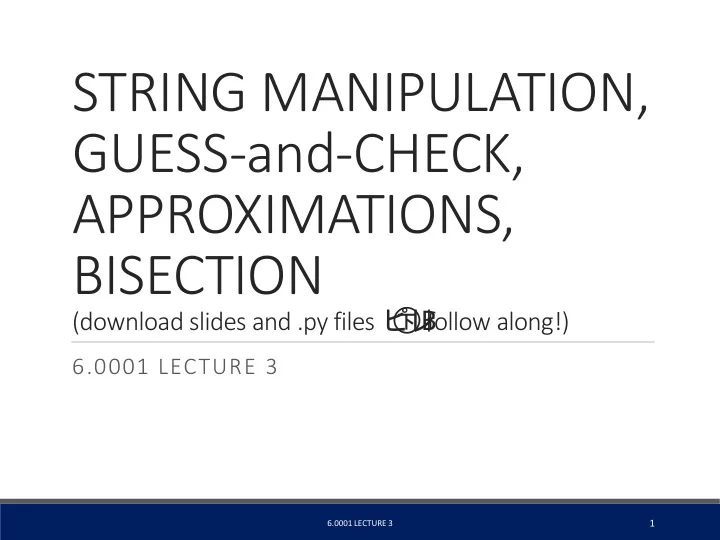

STRING MANIPULATION, GUESS-and-CHECK, APPROXIMATIONS, BISECTION (download slides and .py files � � � � follow along!) 6.0001 LECTURE 3 1 6.0001 LECTURE 3
LAST TIME strings branching – if/elif/else while loops for loops 2 6.0001 LECTURE 3
TODAY string manipulation guess and check algorithms approximate solutions bisection method 3 6.0001 LECTURE 3
STRINGS think of as a sequence of case sensitive characters can compare strings with ==, >, < etc. len() is a function used to retrieve the length of the string in the parentheses s = "abc" len(s) evaluates to 3 4 6.0001 LECTURE 3
STRINGS square brackets used to perform indexing into a string to get the value at a certain index/position s = "abc" 0 1 2 indexing always starts at 0 index: -3 -2 -1 last element always at index -1 index: evaluates to "a" s[0] evaluates to "b" s[1] evaluates to "c" s[2] trying to index out of bounds, error s[3] s[-1] evaluates to "c" s[-2] evaluates to "b" s[-3] evaluates to "a" 5 6.0001 LECTURE 3
STRINGS can slice strings using [start:stop:step] if give two numbers, [ start:stop ], step=1 by default you can also omit numbers and leave just colons s = "abcdefgh" evaluates to "def" , same as s[3:6:1] s[3:6] s[3:6:2] evaluates to "df" evaluates to "abcdefgh" , same as s[0:len(s):1] s[::] evaluates to "hgfedbca" , same as s[-1:-(len(s)+1):-1] s[::-1] s[4:1:-2] evaluates to "ec" 6 6.0001 LECTURE 3
STRINGS strings are “ immutable ” – cannot be modified s = "hello" gives an error s[0] = 'y' is allowed, s = 'y'+s[1:len(s)] s bound to new object "hello" "yello" s 7 6.0001 LECTURE 3
for LOOPS RECAP for loops have a loop variable that iterates over a set of values for var in range(4): var iterates over values 0,1,2,3 <expressions> expressions inside loop executed with each value for var for var in range(4,6): var iterates over values 4,5 <expressions> range is a way to iterate over numbers, but a for loop variable can iterate over any set of values , not just numbers! 8 6.0001 LECTURE 3
STRINGS AND LOOPS these two code snippets do the same thing bottom one is more “ pythonic ” s = "abcdefgh" for index in range(len(s)): if s[index] == 'i' or s[index] == 'u': print("There is an i or u") for char in s: if char == 'i' or char == 'u': print("There is an i or u") 9 6.0001 LECTURE 3
CODE EXAMPLE: ROBOT CHEERLEADERS an_letters = "aefhilmnorsxAEFHILMNORSX" word = input("I will cheer for you! Enter a word: ") times = int(input("Enthusiasm level (1-10): ")) i = 0 for char in word: while i < len(word): char = word[i] if char in an_letters: print("Give me an " + char + "! " + char) else: print("Give me a " + char + "! " + char) i += 1 print("What does that spell?") for i in range(times): print(word, "!!!") 10 6.0001 LECTURE 3
EXERCISE s1 = "mit u rock" s2 = "i rule mit" if len(s1) == len(s2): for char1 in s1: for char2 in s2: if char1 == char2: print("common letter") break 11 6.0001 LECTURE 3
GUESS-AND-CHECK the process below also called exhaustive enumeration given a problem… you are able to guess a value for solution you are able to check if the solution is correct keep guessing until find solution or guessed all values 12 6.0001 LECTURE 3
GUESS-AND-CHECK – cube root cube = 8 for guess in range(cube+1): if guess**3 == cube: print("Cube root of", cube, "is", guess) 13 6.0001 LECTURE 3
GUESS-AND-CHECK – cube root cube = 8 for guess in range(abs(cube)+1): if guess**3 >= abs(cube): break if guess**3 != abs(cube): print(cube, 'is not a perfect cube') else: if cube < 0: guess = -guess print('Cube root of '+str(cube)+' is '+str(guess)) 14 6.0001 LECTURE 3
APPROXIMATE SOLUTIONS good enough solution start with a guess and increment by some small value keep guessing if |guess 3 - cube | >= epsilon for some small epsilon decreasing increment size slower program increasing epsilon less accurate answer 15 6.0001 LECTURE 3
APPROXIMATE SOLUTION – cube root cube = 27 epsilon = 0.01 guess = 0.0 increment = 0.0001 num_guesses = 0 while abs(guess**3 - cube) >= epsilon: and guess <= cube : guess += increment num_guesses += 1 print('num_guesses =', num_guesses) if abs(guess**3 - cube) >= epsilon: print('Failed on cube root of', cube) else: print(guess, 'is close to the cube root of', cube) 16 6.0001 LECTURE 3
BISECTION SEARCH half interval each iteration new guess is halfway in between to illustrate, let’s play a game! GU GUESS SS GU GUESS SS GU GUESS SS 17 6.0001 LECTURE 3
BISECTION SEARCH – cube root cube = 27 epsilon = 0.01 num_guesses = 0 low = 0 high = cube guess = (high + low)/2.0 while abs(guess**3 - cube) >= epsilon: if guess**3 < cube : low = guess else: high = guess guess = (high + low)/2.0 num_guesses += 1 print 'num_guesses =', num_guesses print guess, 'is close to the cube root of', cube 18 6.0001 LECTURE 3
BISECTION SEARCH CONVERGENCE search space ◦ first guess: N/2 ◦ second guess: N/4 N/2 k ◦ kth guess: guess converges on the order of log 2 N steps bisection search works when value of function varies monotonically with input code as shown only works for positive cubes > 1 – why? challenges modify to work with negative cubes! modify to work with x < 1! 19 6.0001 LECTURE 3
x < 1 if x < 1, search space is 0 to x but cube root is greater than x and less than 1 modify the code to choose the search space depending on value of x 20 6.0001 LECTURE 3
MIT OpenCourseWare https://ocw.mit.edu 6.0001 Introduction to Computer Science and Programming in Python Fall 2016 For information about citing these materials or our Terms of Use, visit: https://ocw.mit.edu/terms.
Recommend
More recommend